Lately, I’ve been getting a lot of questions about a baby’s position when introducing solid food into their diet. How to do it? In a sitting position? Half-lying? Or maybe some other? And if in the sitting position then… what about the ability to sit without any help? Because, after all, this skill usually appears later than the moment we start the adventure with solids.
There are quite a few dilemmas, as usual. 😉
Well…
In fact, the sitting position is the best option for a healthy person – if it wasn’t, surely our daily meals would look a bit different. 😉
But how to combine this with psychomotor development? After all, not all children at the age of 6 months, when seated passively, are able to hold this position for long without any assistance.
LET’S START FROM THE TOP:
Initially, the introduction of new foods is aimed at getting the baby acquainted with new tastes and textures, rather than actually satisfying hunger. For the first few months – that is, until the baby’s sitting position is stable enough – it is… (as the name “complementary products” implies) an addition rather than the main way of feeding the child.
It is said that a good time to introduce complementary foods is when the child shows READINESS to do so.
What can this mean?
In the broadest sense, READINESS FOR DIETARY EXPANSION manifests itself in:
- the baby’s ability to assume a sitting position with support,
- good head and neck stabilization,
- showing interest in solid food,
- the ability to grasp and let go off food (disappearance of the grasping reflex),
- disappearance of the reflex of pushing food out with the tongue.
SITTING WITH SUPPORT – WHAT IS IT ABOUT?
The foundation of safe dietary expansion is the ability to swallow solid foods with ease.
Research confirms that the positioning of the head affects the way a baby swallows and whether unwanted aspiration of food content into the respiratory system will occur (Larnert & Ekberg, 1995; Logemann, 1998). Head position is dependent on torso control. In order to achieve proper torso position, a stable pelvic position is essential as well.
According to research, a stable position of the pelvis and, consequently, the higher parts of the body is crucial for the entire swallowing and chewing process. If the pelvis is not stable, the movements of the jaw and tongue, necessary for proper feeding, will be impaired (Jones-Owens, 1991; Seikel et al., 2000).

When we begin expanding a baby’s diet, their pelvis is usually not stable enough yet. And although the control of the shoulders (which are the “frame” for the head position and the free movements of the jaw and tongue) has already developed, full control in the lower parts of the torso still needs some more time to do so. In the supported sit, the main thing is to ensure the correct position of the pelvis, torso and, consequently, the head.
IN WHICH POSITION TO FEED A BABY WHO CAN’T SIT ON THEIR OWN YET?
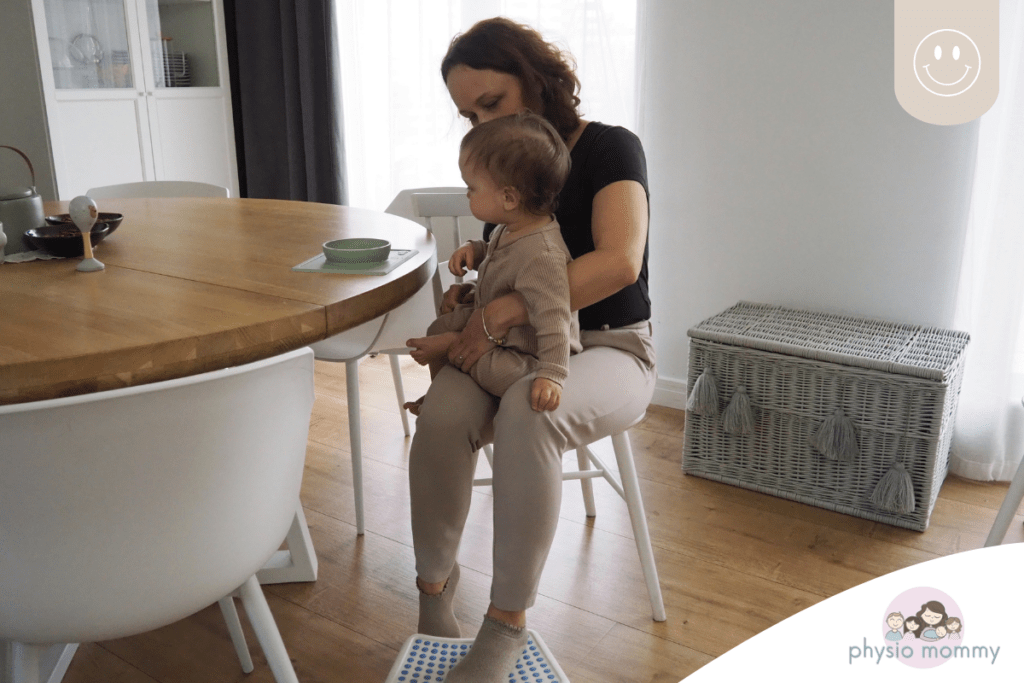
In the diagonal sit, one buttock is slightly lower than the other, and the torso is mobile and can make rotating movements.
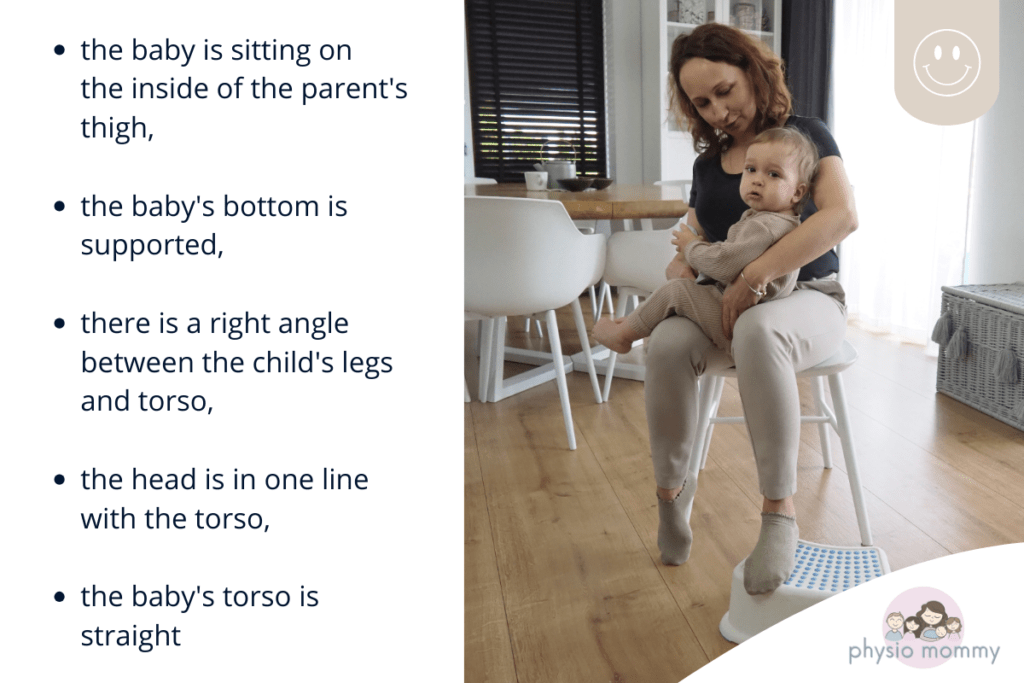
In this position, it is good to sit the baby slightly more medial to the thigh axis. This will make it easy to achieve a right angle between the legs and the torso, and the pelvis will be positioned in the desired anterior (forward) pelvic tilt.
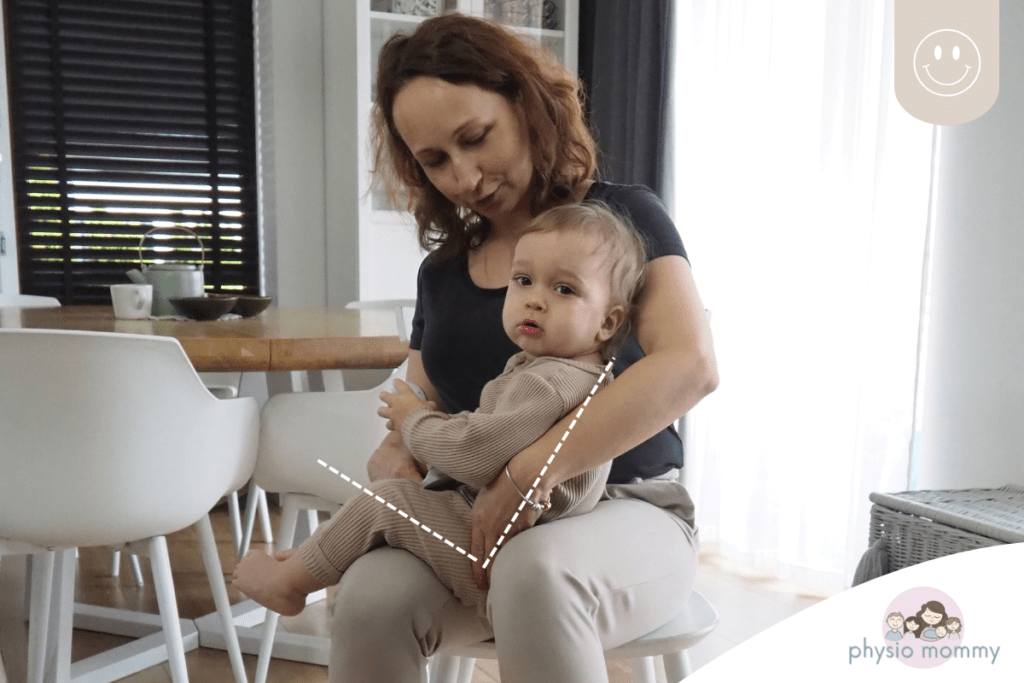
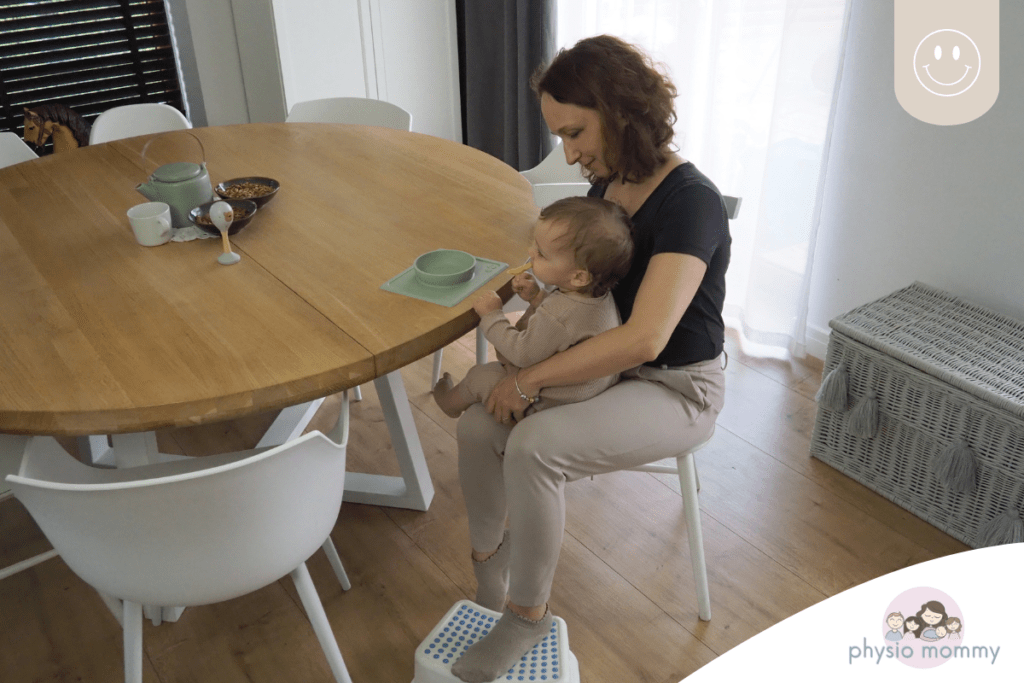
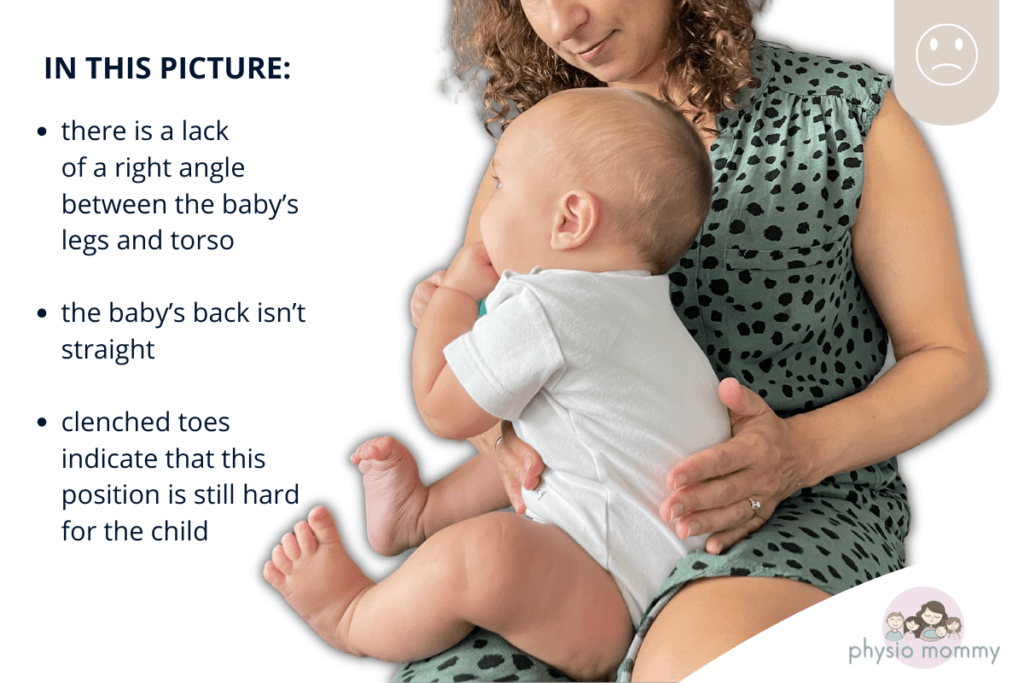
Once the baby is able to maintain a good quality sitting position, we can embark on the adventure with eating in a high chair.

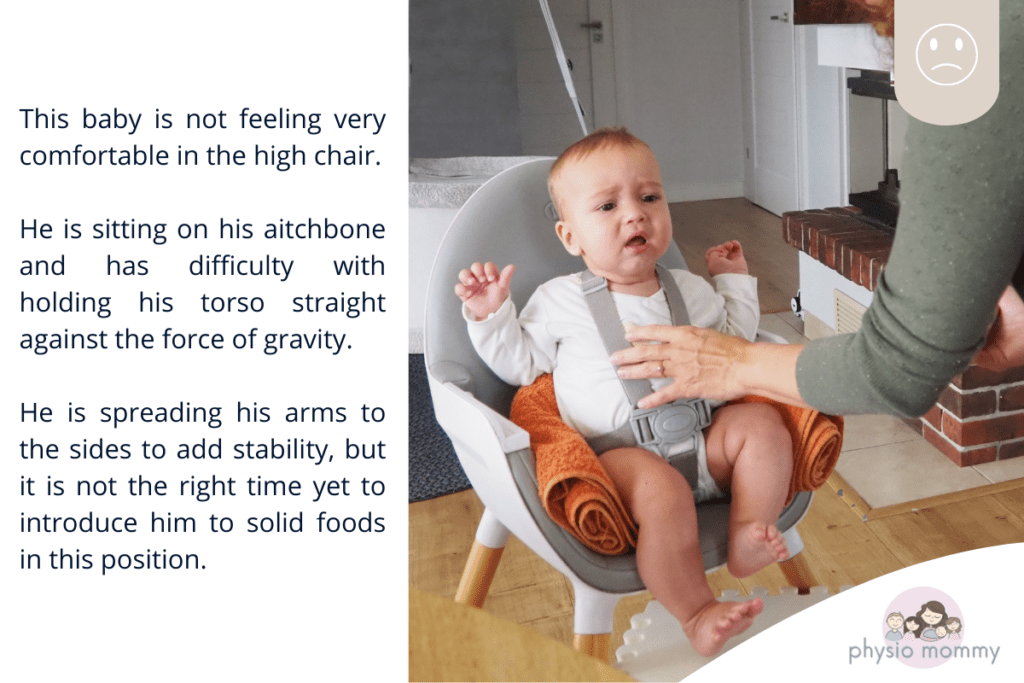
WHAT TO PAY ATTENTION TO?
- Certainly the stable position of the pelvis, which can be provided either by us or a suitable high chair.
- Position of the shoulders – it’s good if the shoulders are not raised too high and not protruding forward. Try swallowing while lifting the shoulders up and forward… Exactly. It is for this reason, among others, why I am not a fan of feeding babies in bouncers or introducing complementary foods too early (when the shoulders are still physiologically set relatively high).
- Position of the head – it should be positioned exactly in the midline of the body, in one line with the torso, so that it is neither leaned forward nor bent back too much (swallowing really is not easy in such a position – not to mention safety reasons…).
WHY SHOULD WE INTRODUCE SOLIDS IN A SITTING POSITION?
- the risk of aspiration of food content into the respiratory system is reduced (feeding older babies and children in a half-lying position is associated with an increased risk of aspiration of food content into the respiratory system: Korth & Rendell, 2015),
- the baby is growing and the anatomical conditions of their mouth and esophagus are changing, so feeding in higher positions is more advisable (Matsu & Palmer, 2008).
EASY IN THEORY, HARDER IN PRACTICE. SO… WHERE TO START?
- When introducing complementary foods into the diet, start by sitting the baby on your lap – in a diagonal sit (for us, spoon-feeding in this position was a bit more difficult, unlike with Baby Led Weaning ;)) or sideways, but make sure that your baby has enough freedom of movement and that their shoulders are not raised up or protruding forward.
- When the baby is “holding the frame” well enough, put him or her in a high chair, making sure that they don’t have too much space to slide sideways in it. (In our case, a regular chair from IKEA worked great – in retrospect, the only downside for me was that it didn’t provide support for the baby’s feet, and the fact that we sometimes tripped over it…).
Why would I not be afraid to sit a baby, who doesn’t sit without assistance yet, in a high chair for a little while?
- First of all, because short-term (!) loading of the spine won’t cause its deformation. Deformities occur with long-term overloading.
- Secondly, because sitting the baby makes them more active.
- Thirdly and most importantly, because I would give my child plenty of opportunities to train on the floor first – to roll over, change positions, prop up, etc. 😉
GOOD LUCK!
Let us know how the dietary expansion looks like for you and what your little ones like the most!!! 🙂🙂
And here… a short video about the mechanism of swallowing 🙂
The content herein is for informational purposes only and will not replace a visit to a physiotherapist or other specialist. If in doubt, please consult with a professional who can examine your baby in person. For the sake of your baby, I do not provide online advice.
For great ideas for spending time and playing with your baby, check out my E-book:
SOURCES:
- Jones-Owens, J.L. (1991). Prespeech assessment and treatment strategies. In M.B. Langley & L.J.
Lombardino (Eds.), Neurodevelopmental strategies for managing communication disorders in children with severe motor dysfunction (pp. 49-80). Austin, TX: Pro-Ed.
- Korth K., Rendell L. (2015). Feeding intervention. In J. Case-Smith & J. O’Briend (Eds.) Occupational Therapy for children and adolescents (7th ed.); (pp 389-460). St. Louis MO, Mosby.
- Larnert G., Ekberg O. (1995). Positioning improves the oral and pharyngeal swallowing function in children with cerebral palsy. Acta Pediatrica, 84, 689-692.
- Logemann J. (2014). Critical factors in the oral control needed for chewing and swallowing. Journal of Texture Studies 45(3), 173-179.
- Logemann J. (1998). Evaluation and treatment of swallowing disorders (2nd edition). Austin, TX PRO-ED Inc.
- Seikel J.A., King D.W., Drumwright D.G. (2000). Anatomy and physiology for speech, language, and hearing (2nd ed.). San Diego: Singular.
Sharing my content with your friends would mean the world to me. Thank you! ❤️